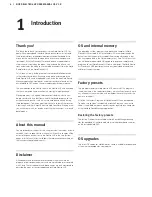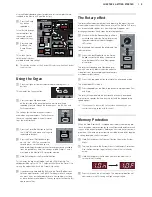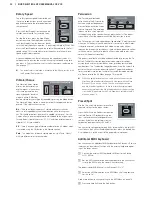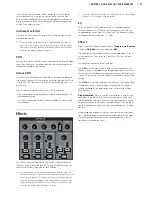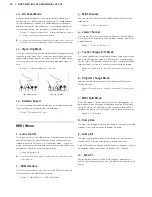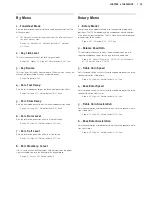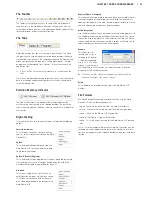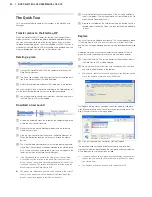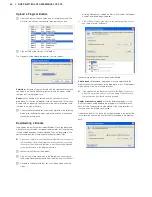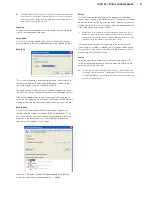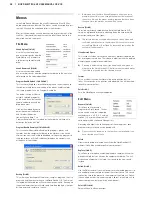
cHaPtEr5NordElEctro4HPrEfErENcE
| 13
This .will .activate .the .organ .split .mode, .but .since .MIDI .Split .is .set .to .On, .
the .Electro .4HP’s .keyboard .will .only .play .the .upper .part .without .being .
split . .
Adjust .the .drawbars .for .the .lower, .external .keyboard .when .the .1/Lo .
LED .is .lit .and .for .the .Electro .4HP’s .keyboard .when .the .2/Up .LED .is .lit .
The drawbars
.
The .drawbars .of .the .Nord .Electro .
4HP .are .represented .by .buttons .
and .LED .graphs . .This .gives .you .a .
big .advantage: .when .you .change .
the .program, .the .correct .drawbar .
settings .are .recalled .immediately .
and .shown .by .the .LEDs . .
The .drawbars .of .Nord .Electro .
4HP .behave .similar .to .their .me-
chanical .counterparts, .with .the .
B3 .and .VX .models .you .“pull .out” .
and .“push .in” .the .drawbars .using .
the .Drawbar .buttons . .The .Farf .
model .uses .the .drawbars .as .on/
off .switches . .
The .buttons .are .special .in .the .
way .that .they .auto-increment/decrement .the .drawbar .value .when .held . .
If .you .hold .a .Drawbar .button .the .corresponding .drawbar .value .will .
continue .to .change .(within .its .range) .until .you .release .the .button . .The .
speed .of .the .automatic .change .can .be .set .in .the .System .menu, .read .
more .about .this .on .page .18 . .
M
WhileMholdingMaMDrawbarMbutton,MyouMcanMpressMitsMsiblingMbuttonM
toMmomentarilyMauto-increment/decrementMinMtheMoppositeMdirec-
tion.
Piano section
The .pianos .in .the .Nord .Electro .4HP .are .
divided .into .six .different .types; .each .
type .can .contain .several .instrument .
models . .You .can .freely .add .new .piano .
instruments .and .samples .via .USB .
using .the .Nord .Sound .Manager .utility .
(see .“Nord .Sound .Manager” .on .page .
20) .
Right .out .of .the .box, .Nord .Electro .4HP .
features .a .fine .collection .of .carefully .
selected .acoustic .and .electromechani-
cal .pianos, .harpsichords .and .sampled .
instruments . .A .lot .of .effort .was .put .in .
to .ensure .that .the .response .and .sound .
of .the .sampled .instruments .matches .
every .nuance .of .the .real .article . .Each .
piano .instrument .has .been .multi .
sampled .in .a .vast .amount .of .veloc-
ity .levels . .That’s .one .reason .why .they .
sound .and .feel .so .authentic .
The .Piano .section .also .includes .the .ability .to .use .samples .from .the .
Nord .Sample .Library, .like .the .Mellotron .or .Chamberlin .sounds .that .have .
been .licensed .by .Clavia .
Clavinet sound
On .an .original .Clavinet .D6 .you .can .select .different .pick-up .and .filter .
combinations .by .pressing .a .number .of .rocker .switches . .This .functional-
ity .is .very .faithfully .simulated .in .the .Nord .Electro .4HP, .which .means .that .
you .get .all .the .possible .original .Clavinet .D6 .sound .variations .(plus .an .
additional .four) .by .selecting .different .pick-up .and .filter .combinations . .
Here’s .how .it .works:
Pick-up type
A .Clavinet .D6 .has .two .separate .pick-ups, .one .on .the .“neck” .and .one .
on .the .“bridge” . .By .selecting .either .one .pick-up .or .both .in .different .
combinations .you .can .alter .the .character .of .the .sound .quite .drasti-
cally . .When .the .Clavinet .is .selected .in .the .Nord .Electro .4HP, .you .use .
the .Model .button .in .the .Piano .Select .section .to .select .one .of .the .four .
pick-up .variations:
Pick-up Type Description
Clav 1 (CA)
Only .the .“neck” .pick-up; .a .warmer, .less .bright .sound .
Clav 2 (Cb)
Only .the .“bridge” .pick-up; .a .bright .sound .
Clav 3 (DA)
Both .pick-ups .on .and .in .phase; .a .very .full .sound .
Clav 4 (Db)
Both .pick-ups .180 .degrees .out .of .phase; .the
fundamental .is .almost .cancelled .out .and .the .sound .becomes .thin .
Clav EQ
The .Clav .EQ .button .works .as .filter .selectors . .By .selecting .different .
combinations .of .the .Brilliant/Treble .and .Medium/Soft .filter .indicators .
you .can .reproduce .all .15 .possible .filter .variations, .exactly .like .on .the .
original .D6 . .Use .the .Shift .button .together .with .the .Clav .EQ .button .to .
access .the .Med .and .Soft .settings .
Acoustics
Activating .the .Long .Release .feature .will .add .a .slightly .longer .release .to .
an .acoustic .or .electric .piano . .This .is .equivalent .to .what .happens .when .
you .adjust .the .damper .tension .in .an .acoustic .or .an .electromechanical .
instrument .
M
M
IfMaMpianoMisMselectedMthatMisn’tMcompatibleMwithMtheMLongMReleaseM
featureMthisMfeatureMwillMbeMdisabled.MOnlyMpianosMofMversionM5.2MorM
laterMareMReleaseMcompatible.
Turn .String .Resonance .on .when .you .want .to .include .the .pedal-down .
samples .in .an .acoustic .piano .sound . .These .samples .will .then .be .used .
when .you .play .and .activate .the .sustain .pedal, .with .a .very .rich .sound .
M
M
TheMSml-sizedMpianosMdoMnotMincludeMtheMstringMresonanceM
samples.
Mono
Hold .Shift .and .press .the .Acoustics .button .to .play .a .selected .stereo .
piano .in .mono . .
Dynamics
Hold .Shift .and .press .the .Type .button, .to .select .the .dynamics .response . .
This .allows .you .to .use .different .response .curves, .which .makes .the .
Nord .Electro .4HP .react .stronger .to .the .velocity .you .use .on .the .key-
board . .These .response .curves .are .only .active .when .you .use .the .piano .
sounds . .
When .all .LEDs .are .off, .the .default .response .curve .is .active . .A .Dyn .
setting .of .1 .makes .it .a .bit .easier .to .reach .the .maximum, .a .setting .of .
2,even .easier .and .the .third .setting .is .the .lightest .response .curve .
Summary of Contents for Nord Electro 4HP
Page 36: ......




